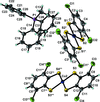issue contents
February 2015 issue

Cover illustration: Six derivatives of 4-amino-1,5-dimethyl-2-phenyl-2,3-dihydro-1H-pyrazol-3-one (4-aminoantipyrine) have been synthesized and structurally characterized to investigate the changes in the observed hydrogen-bonding motifs compared to those in the original 4-aminoantipyrine. Five of the derivatives adopt the enamine tautomeric form, with the sixth derivative in the imine form. See Mnguni & Lemmerer [Acta Cryst. (2015), C71, 103-109].
research papers










A linear heterometallic bismuth–copper coordination polymer containing two types of organic ligands


























 journal menu
journal menu


































